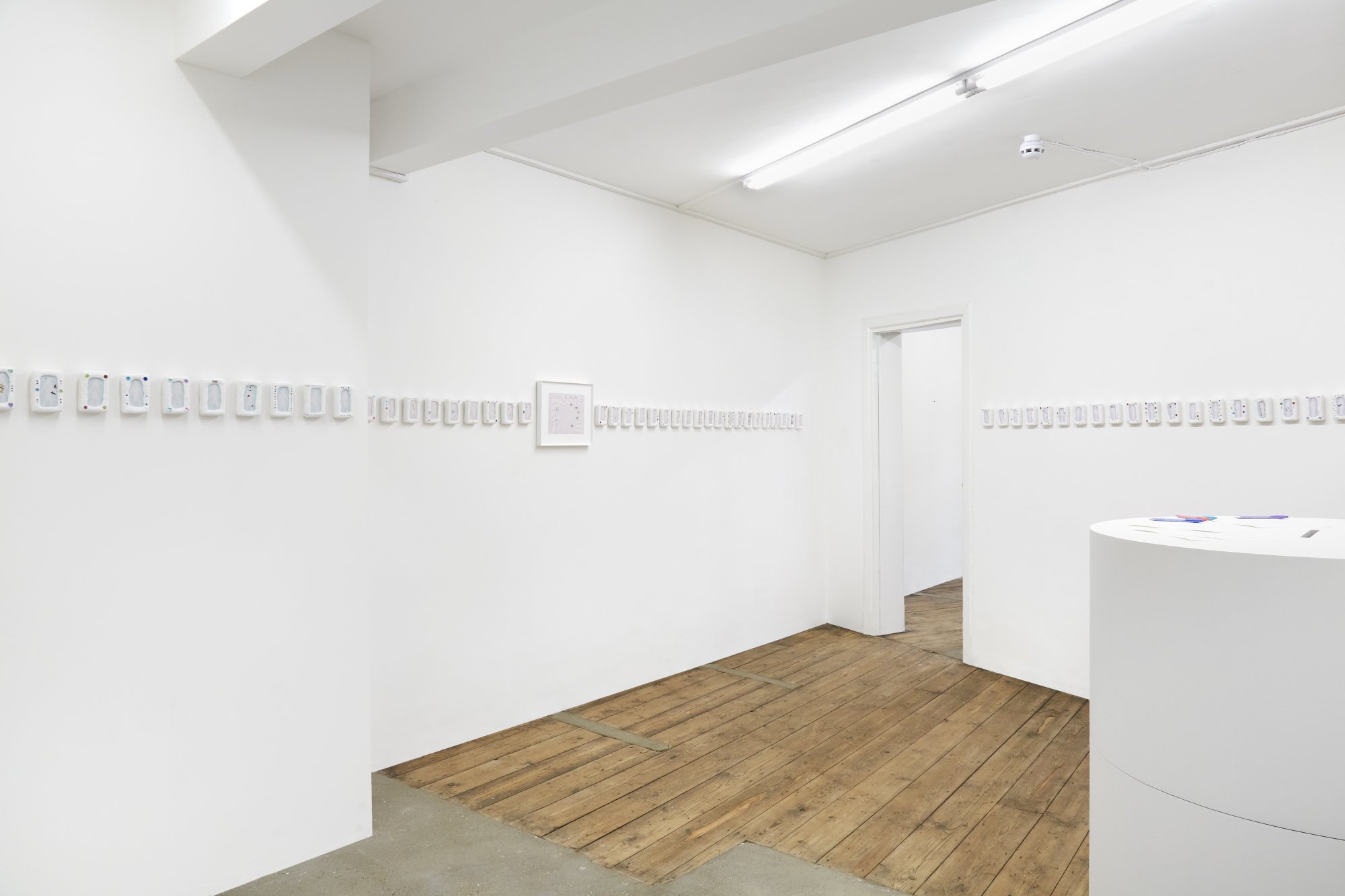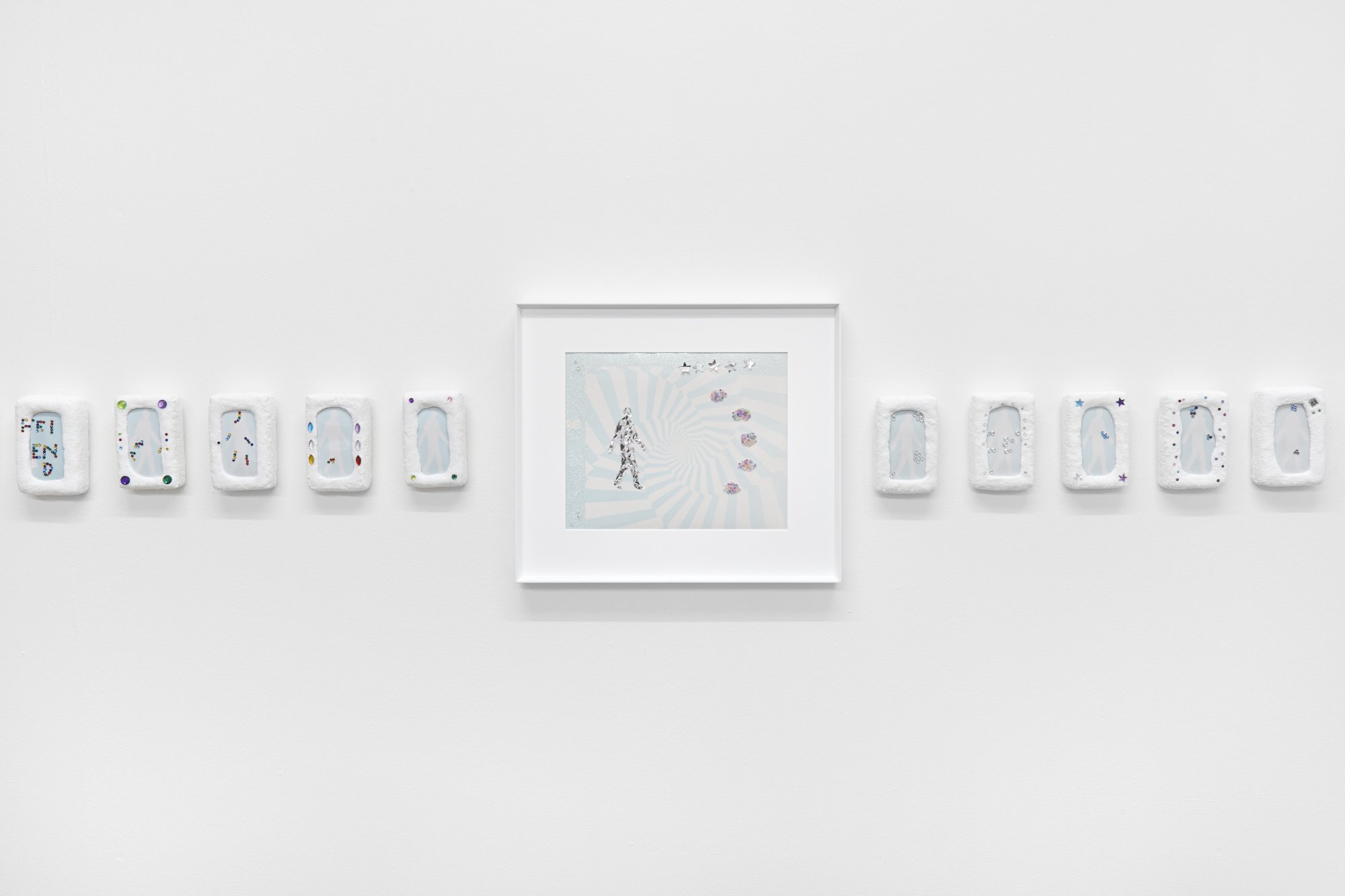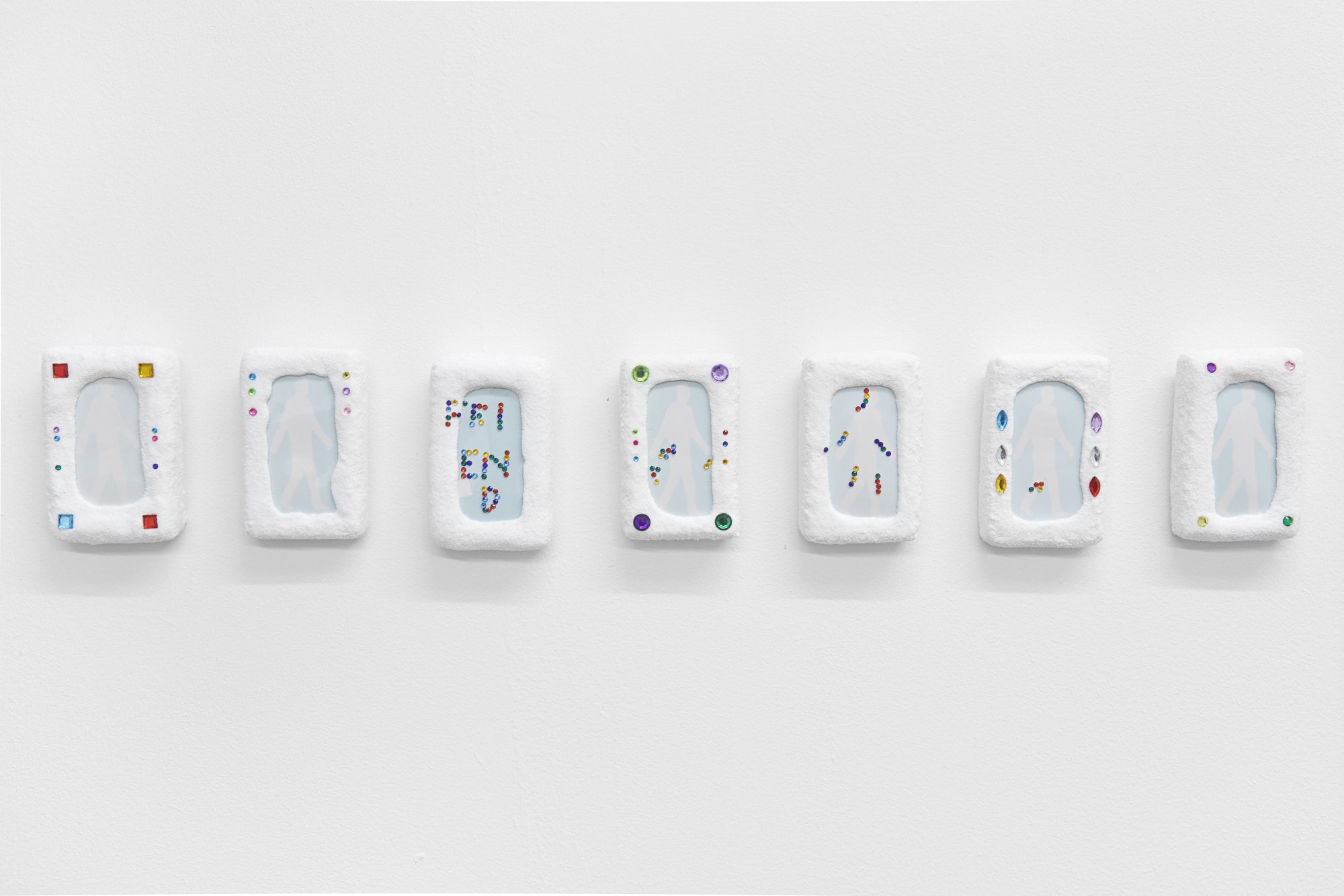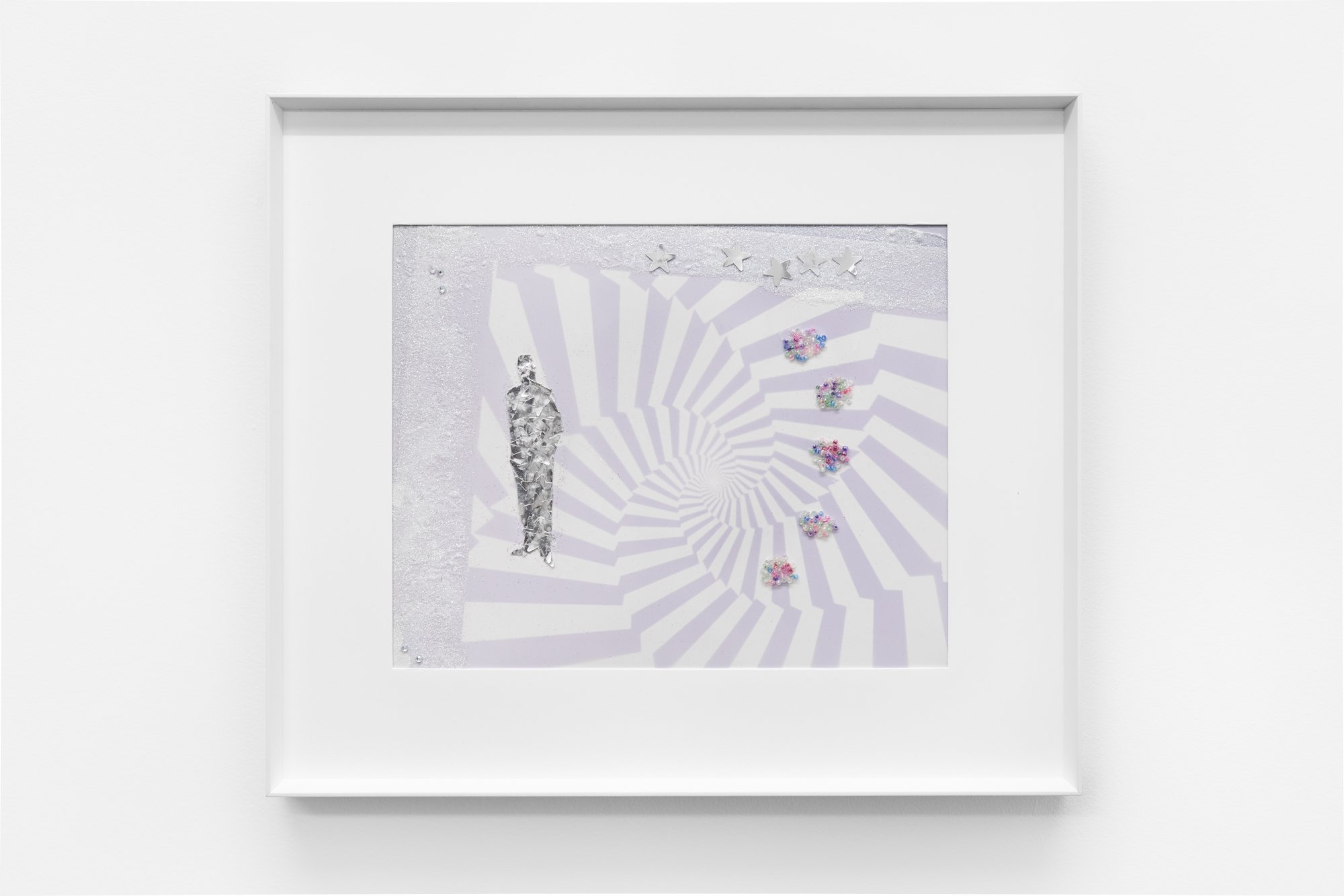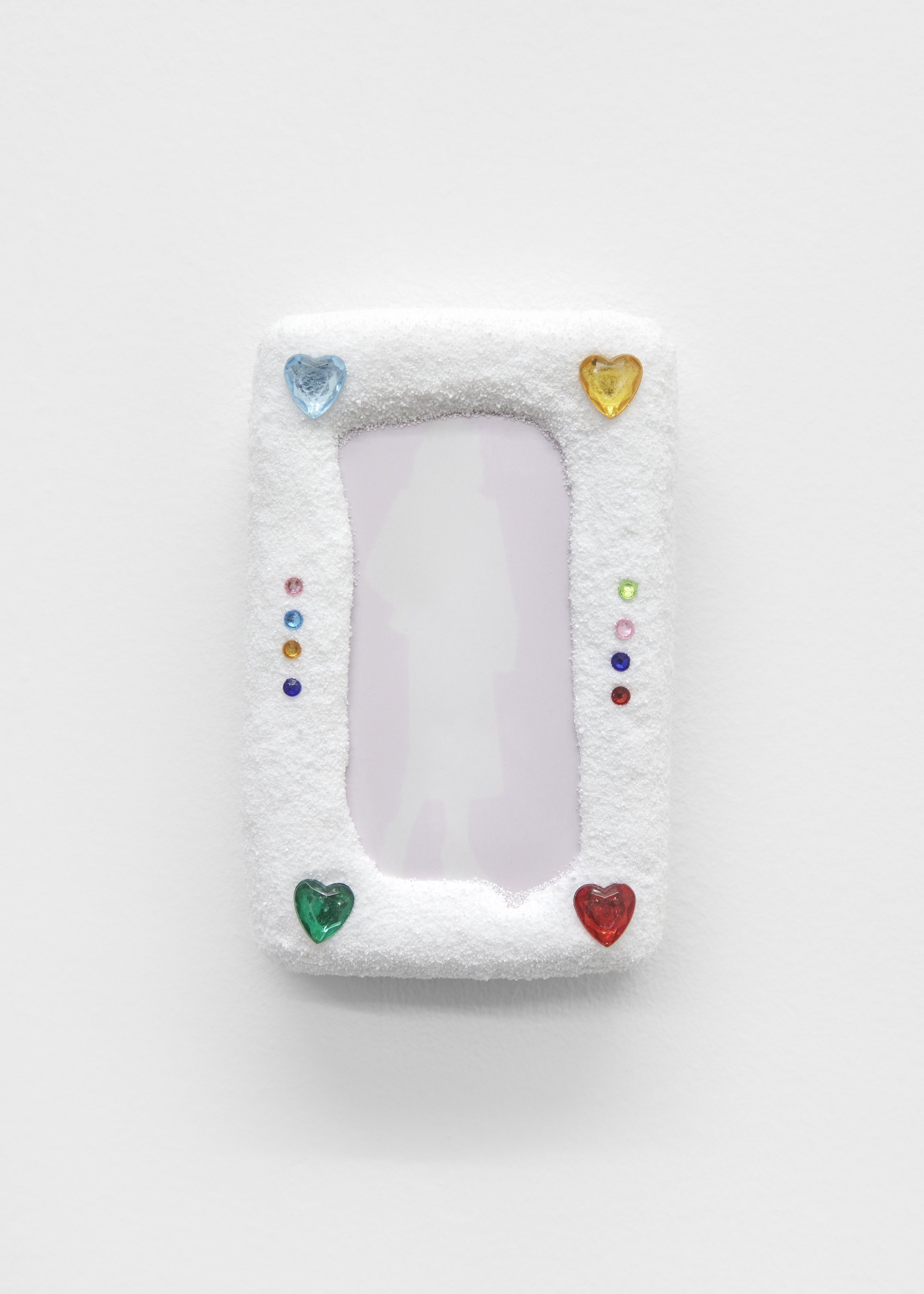Anya Gorkova
Are You Seeing Anyone
23 November 2023 - 13 January 2024
Are You Seeing Anyone is Anya Gorkova’s first solo exhibition and is co-organised by South Parade and general information. It focuses on the desire to love and be loved as a deeply personal yet universal experience.
Gorkova has devised three different silhouettes for the exhibition: a boyfriend, girlfriend and theyfriend (31 of each, like a calendar month). The idea for making a series of gendered friends came from Gorkova buying a ‘Grow a girlfriend’ toy. A toy that contains the most basic yet most important human need - to overcome one’s feeling of separateness from the world.
Gorkova draws these forms as unique photograms on colour light sensitive paper. In each work, the photogram is surrounded by a skin of epoxy, sand and PVA. A resulting surface which resembles sugar or freshly laid snow. Each photogram is adhered to a block of resin. Encased in the resin are rejected photographic darkroom prints of practicing photographers. Rejects collected and shredded by Gorkova over the past year. “I am curious about how by taking someone else’s image and destroying it you can still create one.” Gorkova states.
Gorkova is interested in addressing the problem of non-recyclable waste in photography, whilst addressing a feeling of image deluge, and “the contemporaneity of the human conditions of being”.
The exhibition invites the viewer to fill out a questionnaire about their own dating life, which will be collated by Gorkova for future research. Gorkova has also created a Kissing playlist for the exhibition, playable from a Walkman in the bathroom. Gorkova has also invited Fashion designer Sinéad O'Dwyer to design a garment especially for and inspired by the exhibition.
Photography like dating makes one's existence in the world visible. Gorkova’s exhibition unpacks the complexities of image making, through the lens of human connection as well as disconnection.
-
Anya Gorkova (b.1998), Moscow, lives and works in London. In 2022 they graduated from Central Saint Martins; University of the Art London with a distinction in MA Contemporary Photography. Recent group exhibitions include Allow Cookies (Kupfer Projects, 2023). Recent commissioned performances and events include Tate Film, Interior: The Voice of dreams (Tate Modern, London, 2023), HÄN Archive; Queer heritage of Tove Jansson in collaboration with Finnish Institute (London, 2022), Anya Gorkova Edition prints for fashion designer René Scheibenbauer (London, 2022). Anya is included the upcoming publications: Flora Dunster and Theo Gordon, Photography: A Queer History, (London: Octopus/Ilex, 2024), and Flora Dunster, “Gender, Identity & Queer Theory in Photography Today,” in The Routledge Companion to Global Photographies, eds. Lucy Soutter and Duncan Wooldridge (London: Routledge, 2024).
Awards and nominations include: The Jane Rapley Scholarship, as a talent of all master courses at Central Saint Martins (2021), and Shortlisting for the LVMH Maison/0 sustainability award, (2022). Winner of the Dean’s prize (2022). Their graduation work was acquired by the Central Saint Martins Museum. Gorkova has been featured in Frieze Magazine, Evening Standard (UK), Dazed (UK), Vogue (US), Numero Berlin (DE), Kaltblat Magazine (DE), Replica Magazine (UK), Wallpaper Magazine (UK), Somesuch Magazine (UK/US), Clash Magazine (UK).
-
Anya Gorkova in conversation with general information
general information (gi): When did you start taking photographs?
Anya Gorkova (AG): I started taking photographs from the age of eleven. I was given my first phone with a camera for passing my piano exam in musical school. It was a Sony Ericsson k790i, with a Cyber shot camera. It was 3.2Mp! I was so proud of myself, I felt so cool. I still feel that coolness as I think about it now. Photography always seemed to be magical to me. “Here is reality, but wait, it’s already there, on your screen.” As a kid I was intrigued by the immediacy of that duplication. I took pictures throughout my teens and ended up working in photography. I’ve studied it in three different schools. But while I enjoyed it, I always sensed there was something wrong with it. I’m a very intuitive person - and I quickly realised I needed to study it, to understand it. That’s when I came across the philosophy of photography course at Central St Martins.
gi: How does your training in photography inform your relationship to image making? and can you expand on the hand printing processes you use in the lab?
AG: There has always been a discussion on photography and whether it is an art-form. Perhaps the questions I’m trying to answer are - how does one use photography as an art practice? What does it mean to do so? And what is photographic materiality? A feeling of image deluge was the starting point for asking these questions, and working in photography only enhanced its effect on me. After studying photography, I moved to working in photo labs. When you work in commercial laboratories, you see thousands of photos every day, this shifts your perception immensely. It almost feels like you are in an endless loop on Instagram. And what’s most important is that the images are essentially the same. Girls, trees, water, dogs, parties, food and sometimes nudes.
I work with colour darkroom hand printing, with RA4 light sensitive papers. I print on Fuji Crystal Archive paper. They are very sensitive to the light, so there’s no light in the printing booth. And since it’s all happening in pitch dark, half of the time I have no idea what’s going on (joking, of course I know). The work makes itself in a way. I just set the conditions for it to happen. In time I’ve learnt to see in the dark, it requires absolute presentness and focus. In terms of processes, I combine different techniques and make colour photograms of appropriated images, I photogram my drawings, I also work on papers once they are developed, I guess decoupage and assemblage would be the appropriate terms to use. Often my work is referred to as somewhat sculptural. To me it’s about ‘the making of photography’. And I don’t categorise what I make. I invite whoever is looking at it to decide what they’re looking at.
gi: The exhibition at South Parade is titled, ‘Are you seeing anyone’ - ‘seeing’ makes me think about perception and subjectivity, but there’s a double meaning, as the show is also about dating.
AG: There’s obviously a way of seeing which could come to one’s mind when thinking about photography. I suppose seeing in this body of work is about being able to truly see beyond one’s identity construct, that one must sustain to exist in the world (questionable statement, yet so true to many). To see - is to want to understand, to care, to truly know some-thing | some-one.
Photography is about seeing. Dating is about seeing. To photograph is first to see. To see is also to understand, to ‘get’ someone, therefore, to choose to be or not to be with them. “I see you” is almost like I hear you, but with my eyes. We choose to see something and photograph it; we choose to see someone and start ‘seeing them’. It’s about noticing and being noticed.
gi: Could you expand on the structure of the exhibition?
AG: There are three different silhouettes surrounding the viewer. These are shadows, and a direct reference to the Jungian shadow self, a part of one’s personality that is hidden, repressed, for the most part inferior and guilt laden.
The structure reflects the energies that we have within us, it emphasises the ability to shapeshift. It could be seen as one person’s subjective experience of themselves and their gender or perhaps their date or partner. It is also linked with how we learn about these things when we are younger. In addition, it is a direct comment on the feeling of overwhelm one might feel when on dating apps, but that's a whole different conversation.
Finally, the structure could be a contemporary homage to Tracey Emin’s tent, but more like - ‘All the people that I chose not to sleep with!’
gi: You’ve used a particular colour palette in the show…?
AG: Yes! It originated from me looking at Barbie Dream houses, they all have a very particular pink - turquoise - purple feel to them. There is this woman on YouTube I have been following who bought every Barbie house ever. It is interesting to see how the palettes changed over the years. Only from the mid 80s did the Barbie home adopt its contemporary look. I wonder if that is somehow related to the fashion industry, how it slowly started to assign certain colours to gender binaries, such as when the song “Funny Face -Think Pink”, and its music video was released in 1957.
These colours are a direct reference to the film “But I’m a Cheerleader” with Natasha Lyonne through a much softer, muted palette.
gi: Can you talk about some of the influences that have informed the exhibition?
AG: I grew up listening to my forever favourite Ukrainian, Russian speaking singer - performer Verka Serducka. (Her name means Hope Hearty). Verka was unofficially banned from Russia when I was little. There are two music videos everyone should watch: “Kiss” and “Smeus” which means “I am laughing”.
The idea of making a girlfriend came from me buying myself that toy “Grow a girlfriend”, which I did after someone said to me..
“Anya <...>, you know you can have any girl you want?” which made me question what it means to have a girl, a boy, a they, to explore the foundations of that desire, to “have it”. To re-evaluate my own understanding and reasoning behind it.
There is this societal pressure on having a partner. “Are you seeing anyone..?” It’s like you have to. And if you are not, something is wrong with you. It’s the need many people have to prove that they are loveable - attractive - worthy. To themselves and others. As a result, one has to find that person to be in love with. And the fact that the skill of being by oneself, therefore knowing oneself, which is one of the main foundations of love, is somehow absolutely dismissed. One of my favourite absurdist works, “Lobster” by Yorgos Lanthimos, is a great exaggeration on the subject.
While being ‘in love’ and ‘love’ are two very different things, ‘love’, somehow is commonly confused and advertised as its complete opposite in popular culture.
gi: And you use other photographers' work?
AG: I spent the year going through images that were discarded in darkrooms, put in bins. I had an agreement with some laboratories that I will never show any image to anyone, so I never did. (It was tempting). I shred them and make three dimensional objects; I use resin to hold them together.
“Kids learn by breaking things apart in order to understand life’s secret.” - Eric Fromm, Art Of Loving
I am curious about the potentiality of image creation and how by taking someone else’s image and destroying it you can create one. An absence of the image creates another. By placing multitudes of images beneath the ‘seen’ surface, I comment on the formation of concepts and constructs, on ideas of originality, on collective - individual consciousness.
gi: Another theme is the lens, from the camera lens to the screen which allows you to date online, what’s your interest in the screen?
AG: The currentness of one’s existence is tied to an image. It always has been. Photography has allowed this subtle deception of its nature. Screens are the flat surfaces that we use to consume three-dimensional reality. It is interesting how today, the world, one’s experience of it, has been reduced to a picture on the screen.
gi: Given the subject matter of this body of work and the way you’re dealing with it, is there hope in your work?
AG: Photography brings a duality to one’s existence in the world, which has left many people lonely and disconnected from their body and mind. It offers a connection by disconnecting, it seduces by offering the ultimate ownership of reality by robbing oneself of the actual experience of it. Photography is a deception tool, which can trap oneself into a dysfunctional model of mental reality.
This body of work is deeply melancholic, it raises the questions of artificially created digital social environments that people choose to engage in. It raises a question about the contemporaneity of one’s being, and the way photography has changed the way we exist in the world.
Anya Gorkova, Graffiti piece directly sprayed on gallery floor
Dreamboy, 2023. Green-yellow light on light sensitive paper, photogram, (RA-4) glitter, PVA, superglue, silver star stickers, rocailles tubes mix, in custom aluminium frame, 30 x 35 cm
Dreamgirl, 2023. Green light on light sensitive paper, photogram, (RA-4) glitter, PVA, superglue, silver star stickers, rocailles tubes mix, in custom aluminium frame, 30 x 35 cm
Dreamthey, 2023. Orange light on light sensitive paper, photogram, (RA-4) glitter, PVA, superglue, silver star stickers, rocailles tubes mix, in custom aluminium frame, 30 x 35 cm
Everyday boyfriend (1-31), 2023. 1/2 appropriated up cycled darkroom prints (RA-4), epoxy, sand, PVA, photogram-drawing, green-yellow light on light sensitive paper (RA-4) on d-ring hook, edition of 31 (each unique)
Everyday girlfriend (1-31), 2023. 1/2 appropriated up cycled darkroom prints (RA-4), epoxy, sand, PVA, photogram-drawing, green light on light sensitive paper (RA-4) on d-ring hook, edition of 31 (each unique)
Everyday theyfriend (1-31), 2023. 1/2 appropriated up cycled darkroom prints (RA-4), epoxy, sand, PVA, photogram-drawing, green light on light sensitive paper (RA-4) on d-ring hook, edition of 31 (each unique)
Bathroom: pink paint with diamanté gems
Bathroom: pink paint with diamanté gems, walkman with ‘kissing’ playlist created by Anya Gorkova


